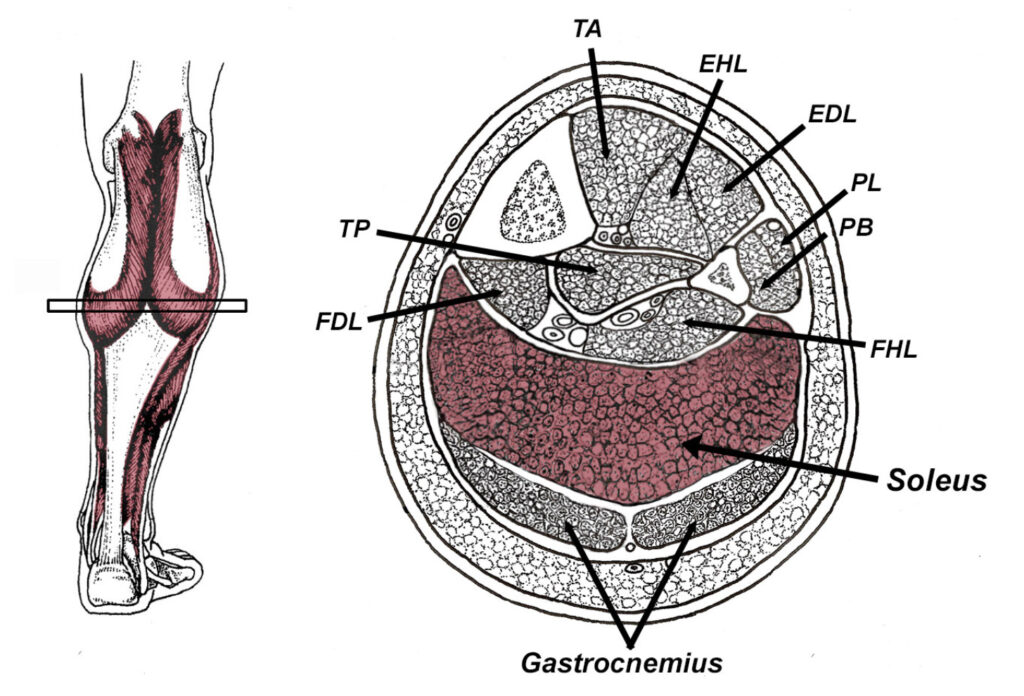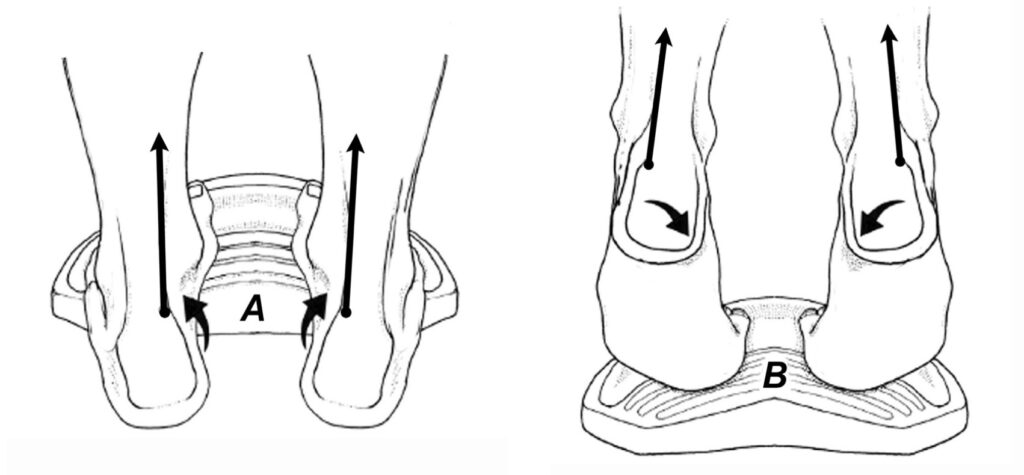Summary:
- Soleus is the largest muscle of the leg, producing force of nearly 8 times body weight during pushoff.
- The world’s fastest marathon runners have the largest soleus muscles, and weakness of the soleus correlates with the development of Achilles tendinopathy.
- Soleus plays an important role in protecting the anterior cruciate ligament and preventing valgus collapse of the knee.
- As we age, soleus prevents cognitive decline in seniors with low blood pressure.
Despite sharing a common tendon, the soleus and gastrocnemius muscles function independently during stance phase with soleus playing a crucial role in limiting knee flexion by controlling movement of the tibia relative to the ground, while the gastrocnemius opposes this action by simultaneously flexing the knee and hip (1). Soleus is especially important during propulsion, as it generates a force of 8 times body weight to propel the body forward (2). This figure contrasts with gastrocnemius’s ability to generate vertical forces of only three times body weight (2). Soleus’s incredible strength comes from its large cross-sectional area. In a cadaveric study comparing muscle size and morphology, Japanese researchers show that soleus has 1.5 times more volume than gastrocnemius, three times the volume of tibialis posterior, and six times the volume of flexor hallucis longus (3) (Fig. 1).

Notice how soleus is far and away the largest muscle below the knee.
Additional research shows that unlike gastrocnemius, which is comprised mostly of fast twitch fibers (4), soleus possesses nearly 100% slow twitch muscle fibers (5), which is why it is so important in distance running. The muscle fibers of soleus have also been shown to lengthen at a slower rate than gastrocnemius muscle fibers (6), allowing soleus to more efficiently store and return energy. All of this information explains why a recent MRI evaluation of muscle volume in high-level marathon runners discovered that the fastest distance runners have the largest soleus muscles (7). In this study, gastrocnemius volume had no correlation with running speed.
Besides being essential for fast distance running, soleus is also important in the treatment and prevention of Achilles injuries. In an interesting ultrasound evaluation of injured Achilles tendons, Counsel et al. (8) confirmed the vast majority of Achilles injuries happen at the midportion of the deep surface of the Achilles tendon, which is where fascicles from the soleus pull with the greatest force. Apparently, variation in interfascicular sliding plays a huge role in the development of Achilles tendon injuries.
In an innovative study comparing force output between the gastrocnemius and soleus in runners presenting with midportion Achilles injuries, O’Neill et al. (1) show that injured runners have large deficits in strength and endurance, which the authors relate primarily to soleus weakness. In fact, the authors measured strength bilaterally and determined that compared to healthy controls, the soleus muscle in individuals with Achilles tendinopathy is significantly weaker on both the symptomatic and asymptomatic side. The clinical implication of this research is that soleus weakness precedes the Achilles tendinopathy and rehab exercises should be performed bilaterally. Soleus weakness may also explain why an MRI study of 149 calf injuries in elite Australian Football players revealed that 85% of calf strains occurred in soleus (9). Even worse, more than 91% of reinjuries occurred in the soleus and these injuries took longer to heal than gastrocnemius injuries.
Moving up the kinetic chain, some great research has shown that soleus plays a key role in preventing anterior cruciate ligament injuries. Because this muscle prevents anterior translation of the tibia relative to the femur, soleus is capable of exerting a powerful posterior force to prevent stretching of the ACL during sport (10). To prove this, researchers from Australia calculated posterior shear force generated by all potential knee stabilizing muscles and determined that by limiting anterior translation of the tibia, soleus provides greater protection to the ACL than the medial hamstrings and biceps femoris (11). While every rehab specialist knows to strengthen the hamstring muscles in order to prevent ACL injuries, few ACL prevention programs incorporate soleus exercises. The same Australian researchers proved the soleus muscle also plays an important role in preventing valgus collapse of the knee (11). By pulling the tibia posteriorly during initial ground contact, soleus keeps the knee aligned while gluteus medius and the hip rotators prevent excessive internal femoral rotation. Preventing valgus collapse is one of the most important aspects of gait rehab, and all too often clinicians overly focus on just the hip musculature.
In what I think is the most fascinating research on the soleus muscle, McCleod et al. (12) show that soleus activity may play an important role in preventing age-related cognitive decline. According to the authors, age-related cognitive impairment is strongly correlated with reduced cerebral blood flow. The authors point out that between the ages of 30 and 70, cerebral blood flow declines 30 to 50% and that even mild exercise can enhance cerebral circulation thereby limiting the rate of cognitive decline. Unfortunately, nearly 2/3 of adults over 75 do not engage in any physical activity whatsoever, and to make matters worse, it is not uncommon for individuals over 70 to spend more than 12 hours per day sitting (13). In order to maintain cerebral blood perfusion, muscle activity is necessary to increase venous return to the heart, which in turn enhances cardiac output. According to Padberg (14), the soleus muscles are the body’s primary muscle pumps responsible for forcing the return of blood from the lower extremity to the heart.
To evaluate the potential relationship between soleus activity and cognition, McCleod (12) used mechanical stimulus to force the soleus muscle to contract for one hour daily for four months in hypotensive senior citizens. At the end of that time, compared to an untreated control group, the seniors who performed soleus exercises demonstrated marked improvements in cognitive performance during executive function tests.
Given the connection between soleus strength and running performance, ACL stress, Achilles injuries, valgus collapse and even cognitive performance, it is important to keep the soleus muscle as strong as possible, especially as we age. Maintaining soleus strength and endurance is especially important for masters’ runners, as research shows that older runners slow down because of reduced force output in the calf muscles, not reductions in hip or knee force output (15).
My favorite way to strengthen the soleus is to perform 4 sets of 25 repetitions of bent-knee heel raises on the ToePro exercise platform. Compared to conventional heel raises performed on a flat surface, the downward lateral slope on the device forces soleus to use a larger percentage of its muscle fibers as it moves the rearfoot from a fully inverted to everted position (i.e., the medial fibers of soleus invert the heel while the lateral fibers evert the heel) (Fig. 2). More importantly, the posterior slope of the ToePro keeps the soleus in a lengthened position. Keeping soleus lengthened is essential as a growing body of research is showing that exercising a muscle in a lengthened position produces significantly faster increases in strength, muscle volume, and tendon resiliency than exercising a muscle in a neutral or shortened position (16-18). Also, when it comes to increasing muscle volume, the 4 sets of 25 light resistance exercise protocol has been proven to be just as effective as heavy resistance exercises (19), and the light resistance workouts are less likely to produce injury. Whether you are treating biomechanical problems in elite athletes or inactive senior citizens with cognitive impairment, strengthening the soleus is often the key to effective treatment intervention.

